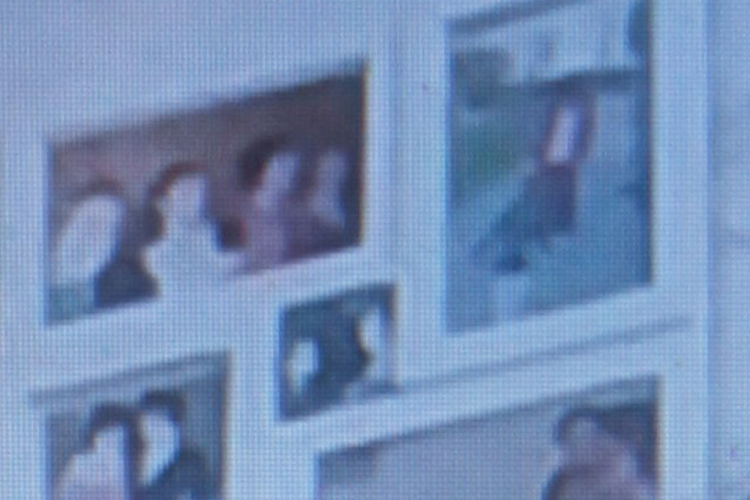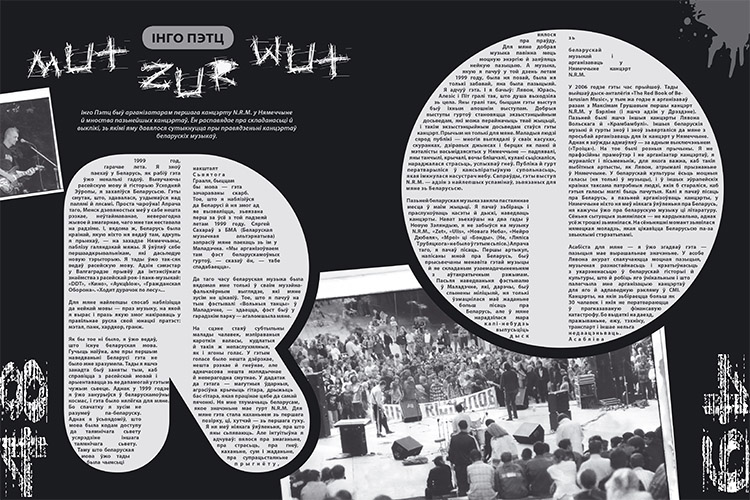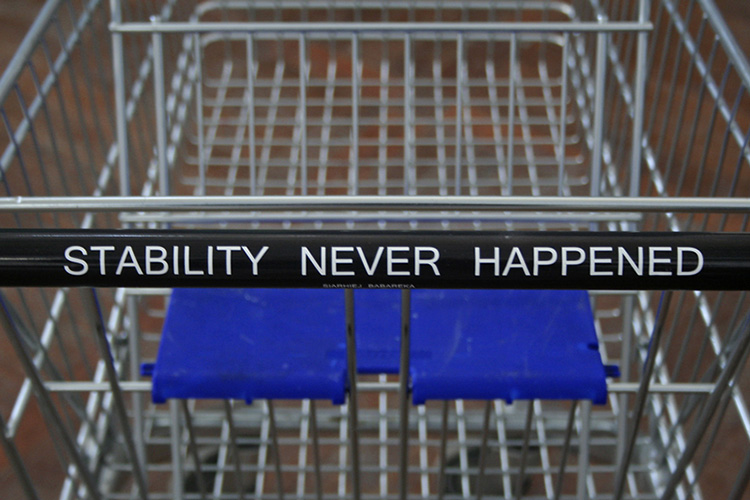
Аўтар: Volha Bubić, 16/10/2014 | ART Cult Aktivist project XXY
ZHANNA GLADKO: THE RIGHT OVER ONE’S OWN BODY
The problem of the relationship between looking at oneself from the inside and from the outside – between the individual and the collective, the personal and the public – remains one of the eternal dilemmas which has been a subject-matter of research done by representatives of various domains, including the sphere of art. Identity and its numerous manifestations became an object of attention of curators and participants of the art project «XXY», which opened in early September 2014 in the Minsk gallery «Ў». Not for the first time within this gallery’s space we can find the works of a contemporary Belarusian artist Zhanna Gladko.
Nine «anti-self-portraits» and one portrait were presented as a separate complete exposition, creatively aiming at showing mask-clichés that are associated in our society with the image of women.
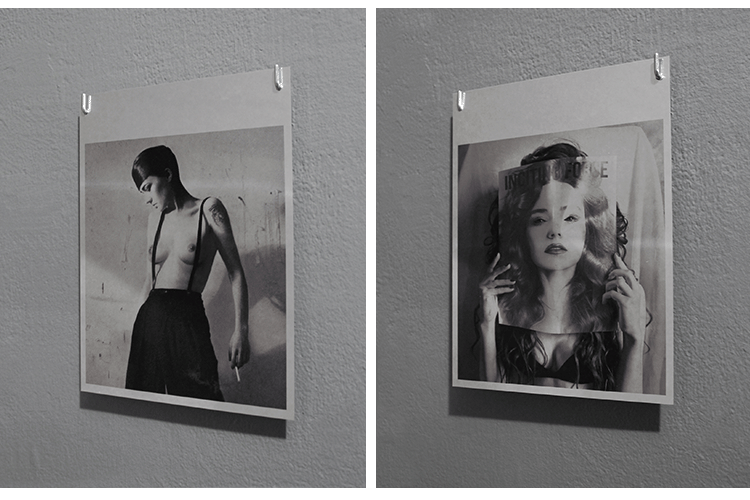
Zhanna Gladko, «Inciting Force» / «XXY» exposition
Unfortunately, the topicality of the issue of the stereotypical models of behaviour imposed on women by the society in the Belarusian context leave no doubt. Belarusian mass media platforms easily allow themselves to positively proclaim the ideology of superiority of one sex over the other, thus justifying its discrimination. Just the other day I read in the Belarusian Internet an interview with the photographer Alexander Konotop who was introduced as «one of the most famous and highly paid portrait photographers in Belarus.» The journalist Dmitry Korsak quotes Konotop’s opinion who dwells on gender stereotypes in photography using such attributes as «a blonde who photographs her breakfast and her ass in the mirror 400 times day after day,» at the same time accompanying the image of a male photographer with such epithets as «professional», «theoretician» and «critic».
«Breakfast served on the table, «a look» in a club toilet, beaches and palm trees shot on vacation seem to be banal themes for photographers, but our blonde with her iPhone continues to practice hard and achieve very good results, because shooting is a tool that allows her to stand out among her peers», — says Alexander Konotop. As you can see, in his discourse women are seen as creatures burdened with a motivation to become by all means noticeable in her personal environment.
Is such a statement chauvinistic? In my opinion, it certainly is.
Probably the propagandist himself does not actually realize being a bearer of the distorted patriarchal stereotype: Alexander Konotop’s understanding of the beauty of the female corporeality becomes clear after giving even a superficial look at his creative portfolio. On the photographer’s site we can evaluate the works of the Belarusian «professional»: half-naked girls with a temptingly placed legs, located under the necessary angle, brides with cigarettes, seductive bright red lips and high heels. This typical view of the woman is characteristic not only for the given photographer – it is generally accepted in our country. It is these standards of beauty that both teenage girls and young women use now, leaving behind unpopular models of Princess Diana or Margaret Thatcher.
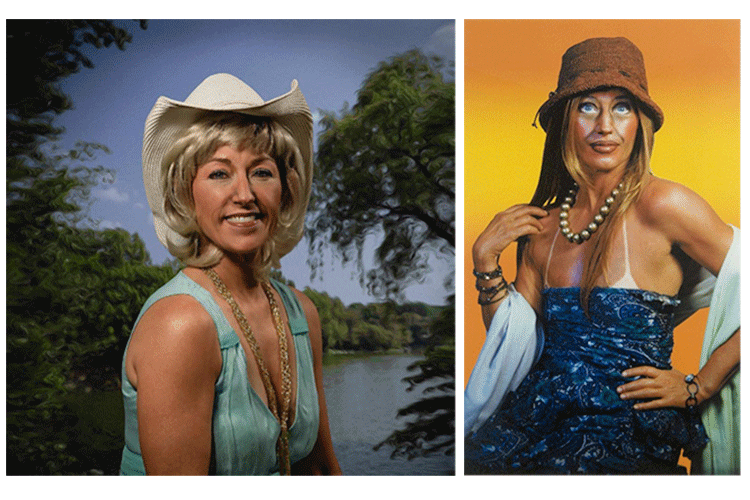
Cindy Sherman’s self-portraits
Handling stereotypes has been a world popular topic since the 1950s. It is enough to recall, for example, such a large-scale project as «Untitled Film Stills» by an American photographer Cindy Sherman, which received a wide public attention. In her project, Cindy tried on the images of representatives from various social groups: from a housewife to a business lady, thus producing in the exaggerated form a distorting mirror of the reflections of American women. A number of critics very finely and accurately described Sherman’s self-portraits as «commentaries to cultural stereotypes of women popular in the media and society», which is conceptually emphasized by the author herself by the fact that she did not actually give her photos any title, leaving only their serial numbers as photo captions.
A Korean photographer Nikki S.Lee also works with rethinking gender stereotypes in her series named «Parts» — a psychological study of self-images in the gallery of staged fragments of interpersonal relations. The impetus for the creation of the series was an idea about multiple identities that each person has in a kaleidoscope of social bonds. «I realized that my own identity changes depending on who I am dealing with … Someone can make me feel independent and assertive, while I become feminine and delicate with others» — Nikki explains. And whereas in the center of Cindy Sherman’s creative works we see a collective portrait of characters, determined by the collective consciousness, Nikki S.Lee rather plays with a personal story of her identity. The form of her pictures reminds more a set of light-minded family cards that accidentally fell out of the album.
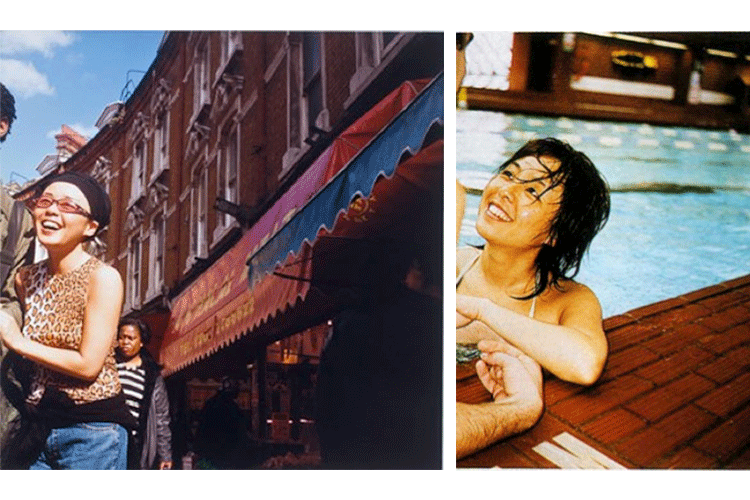
Nikki S.Lee, «Parts» series
Nowadays the topic of gender stereotypes is been quite a well-developed one in world photography, while in Belarus it is just beginning to gain popularity. The creative focus of the Belarusian artist Zhanna Gladko rests on culturally and socially constructed masks that she is trying to make visible in the project «Inciting Force». She forms a collection of photographs that she metaphorically describes as «a set of fragments or parts of the construct called female identity». In her works we find an individual harsh critical look at how women are accustomed to be seen today. We face a visual representation of how they may feel when forced to try on the masks of «a blonde with a cigarette» — submissive, unemotional, one that tries to play according to the rules of the industry of beauty and glamour.
«One of the perspectives presented in my series deals with «cultural symptoms» of our society. This is an attempt to show a peculiar view on the female, on femininity, on women’s role, an attempt to analyze the roles associated with these stereotypes and the ways of their representation in advertising, media, in visual and textual arts, etc. .. In the series there is also a place for the stereotypical roles of women – the roles which may be critically perceived by feminist theory: a female muse, a woman and a mother, a femme fatale — the images that correspond to the patriarchal culture, to the male’s ideas about women. However, I do not consciously strive for deerotization or de-aestheticization of a female sexuality, because I see in this a powerful tool that allows us to make the problem more visible» — Zhanna Gladko comments on the «Inciting Force» exposition.
Zhanna emphasizes that she does not aim at declaring war on men. Basically, she puts into question the culture of a masculine type, which makes it difficult for both the sexes to fully open up.
According to the artist, the patriarchal culture type of culture artificially constructs an image of women and men, causing not only the former, but a large number of men as well to suffer from the fact that they are actually unable to meet the specified standards accepted in the society.
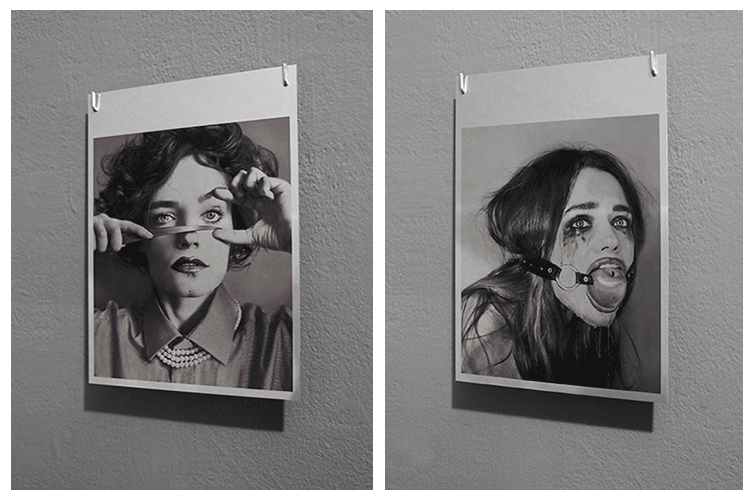
Zhanna Gladko, «Inciting Force» / «XXY» exposition
Commenting on the clichés she was working with in the course of the project’s realization, Zhanna Gladko notes that in Belarus they are clearly determined by the general perception of women. Women are seen as infantile creatures, whose status borders with that of a child, — «a substance that does not possess a sufficient degree of intellectual and physical development». At the same time men are traditionally perceivedas subjectswho are capable of reflecting, active subjectswho observe, who are characterized bythe desire to possess, including the desire to possess a woman who is always viewed as a passive object presented to his gaze. Moreover, women are often denied the right over their own body and the right to control it the way they want, including the right to renounce motherhood.
Thus, the artists sees the reconstruction of women’s right to sexuality and corporeality as one of her tasks set within the exposition «XXY».
«Today, there is a problem of not only of the male gaze on the female, but the woman gaze on the female, too – Zhanna Gladko explains. – In our society, a woman seems to be reflecting a double gaze: on the one hand, this is a male gaze within the patriarchal system, on the other – it is the woman’s proper system, which is often perceived as marginal, put into the position of the Other».
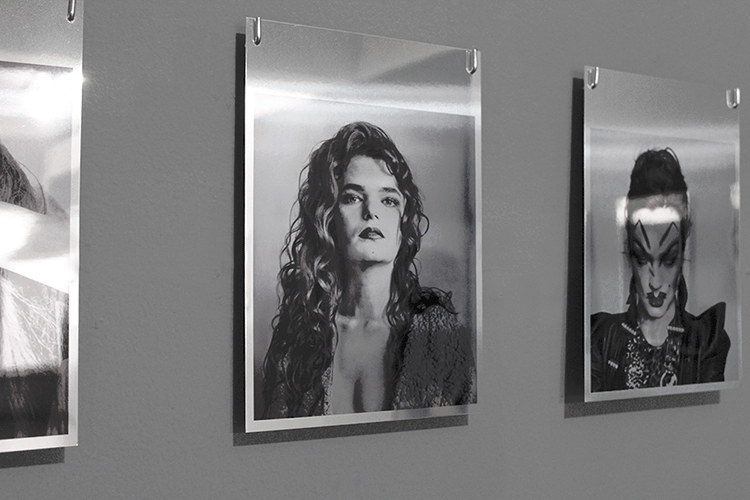
Zhanna Gladko, «Inciting Force» / «XXY» exposition
Zhanna believes that every image in her series is ambivalent, contradictory and conflicting. She sees the woman in the center of the project and treats her as a starting point. «A woman is making too much effort to match her own self-perception. Rather than remain passive, she actively imposes her own point of view on the viewer, turns into «a self» with which the viewer is forced to be identified. But at the same time, her own leveling occurs … In a series I am actually missing as a person – in none of the images my own self as that of an artist can be located. These pictures are anti-self-portraits, masks that I just try on.
Here I am present in many images, but I do not exist. And it is very difficult to understand who the author is. Is it a man, according to whose requirements these images were created? Or a woman whose identity is formed from a set of elements imposed on her? Or maybe it is me, who exists in various interpretations, trying to collect herself into a certain entity – a single and complete one? Or maybe it is the viewer him/herself, who is both a critic and an interpreter?» – the author asks herself. «I am interested in all the positions declared, and the name of the project «Inciting Force» reflects my personal twofold desire: on the one hand, it is a desire to avoid the role of the author, creator, subject – which are the characteristics of a fallos-centered system, on the other hand – I aspire to take the position of a masculine subject, triggering in myself the qualities that conform to this standard».
The artist’s photos shot at different angles were designed with an eye on the popular clichés of mass culture, they are printed on metal plates with an almost mirror-like surface. Zhanna explains her choice of the material mentioning that it gives another semantic focus to the concept stated:
«In this project the theme of mirror is important to me, that is the theme of reflection and gaze. Glossy metal was not taken by chance: it reflects heavily, preventing the viewer from looking at the image, because in the process of looking at the work, he/she also observes his/her own reflection. Actually, this fact not only interferes with the perception, but it also misleads us. In the same way the initially aestheticized images often distract us from the problem declared, which, however, reflect the state of our society and of the fact stated in the framework of the exhibition. They exist, but they are melting, get distorted, covered with additional reflections, fade away, or their denial occurs — they actually seem not to exist.
The society sometimes «does not notice» or even eliminates the so-called marginal or deviant people claiming the existence of «normality» as the absolute public value.
The same thing happens with the person. For me, the aspect of an ambiguous identity seems to be an important one, that of «blurring subjectivity». Identity as something fragmented, unstable, changeable, something that escapes. There is no certain homogeneous entity called the woman which confronts that of the man. I would rather be talking about multiculturalism and tolerance».
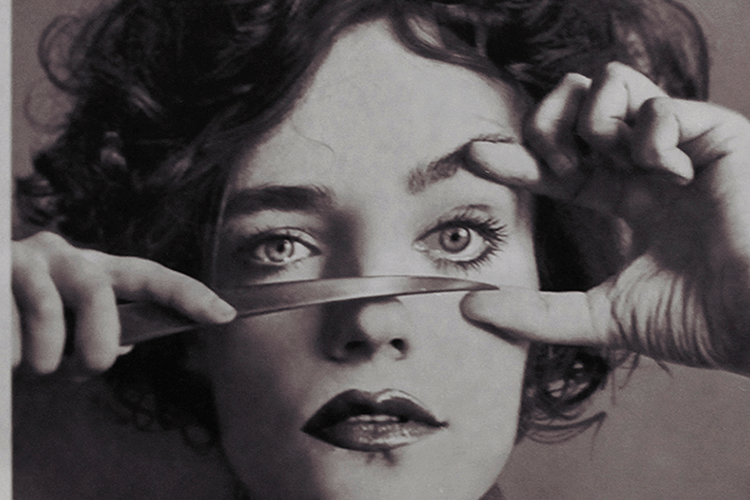
Zhanna Gladko, «Inciting Force» / «XXY» exposition
«Inciting Force» multiplies masks, playing by the rules of the postmodern society it literally washes away our identity. Helplessly trying to give a closer look at the photographs, we move from side to side, endlessly changing the position of our body and consequently our point of view: a non-Zhanna’s face from the metal surface is mixed with our own gaze and the gaze of the Other. In the review on one of the photographs by Zhanna Gladko a poetess and critic Volha Hapeyeva writes: «It is not a secret that women artists often use their own bodies in their works, however, we should not think that it happens as an act of some kind of «narcissism», everything is much more serious and hopeless».
Hopelessness does seem a peculiar tag which today accompanies the problem of women’s identity in the Belarusian society. Will we ever manage to combine all these multiple images in a harmonious collage that would not enter into contradiction with our own perception? The question remains open, and we are left to look in the mirror of our society at an image of another woman. That of ourselves.
Volha Bubič. Translated from Russian.
Photos © Zhanna Gladko
Opinions of authors do not always reflect the views of pARTisan. If you note any errors, please contact us right away.



